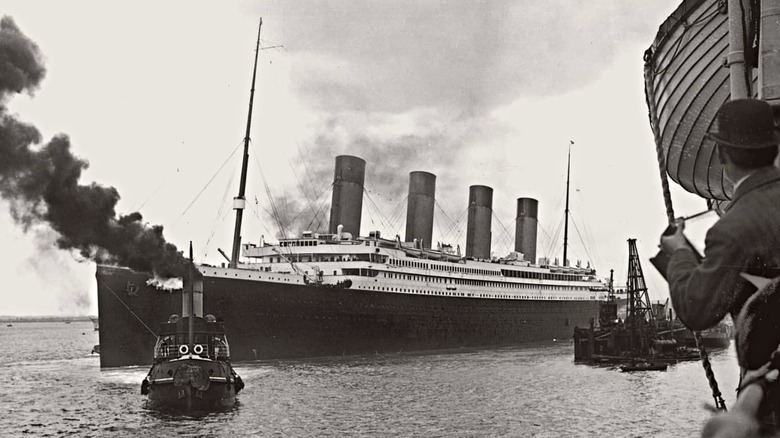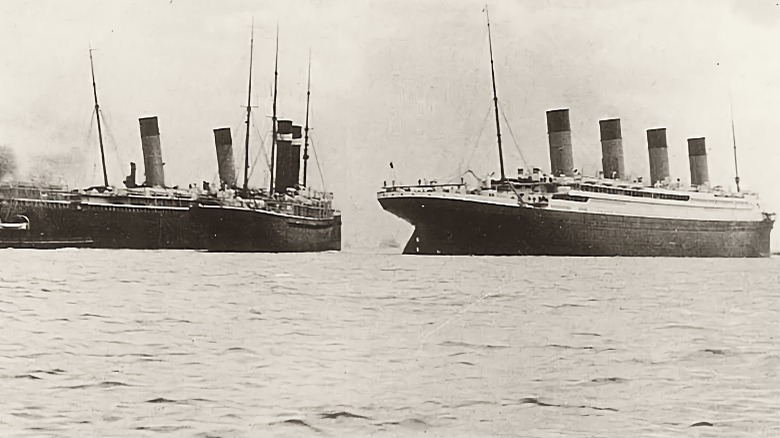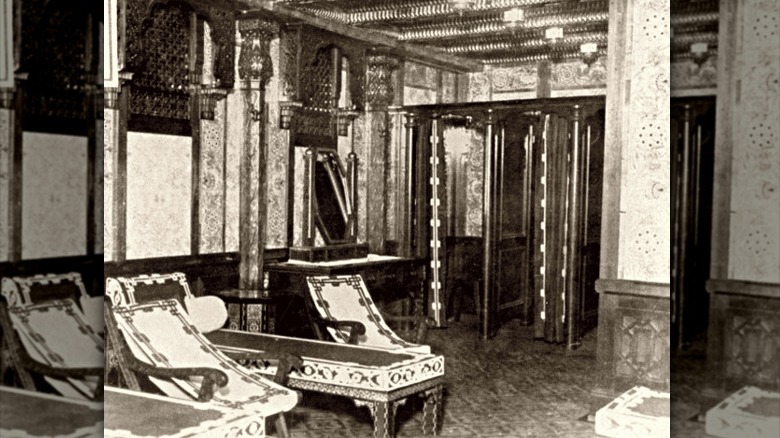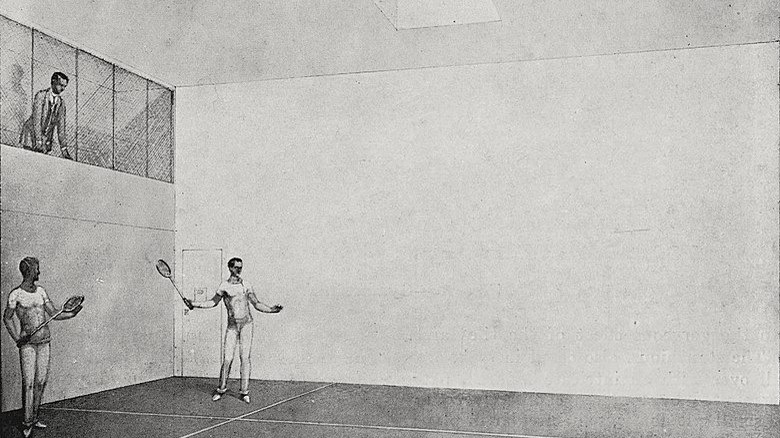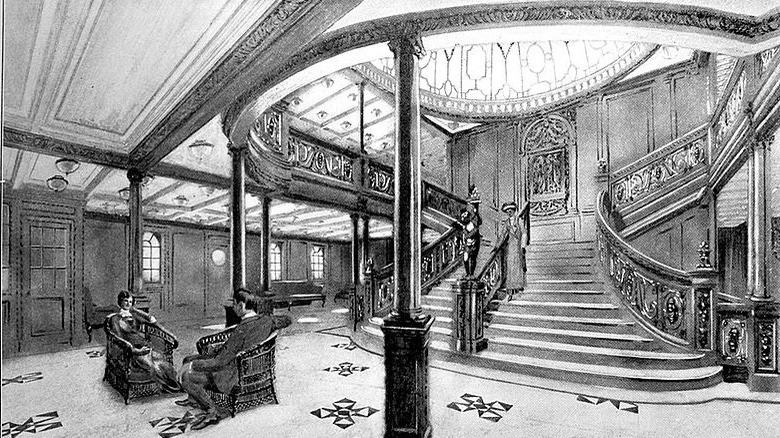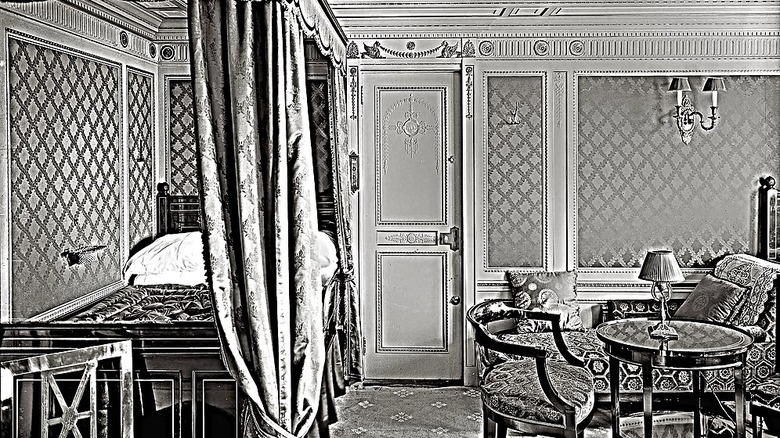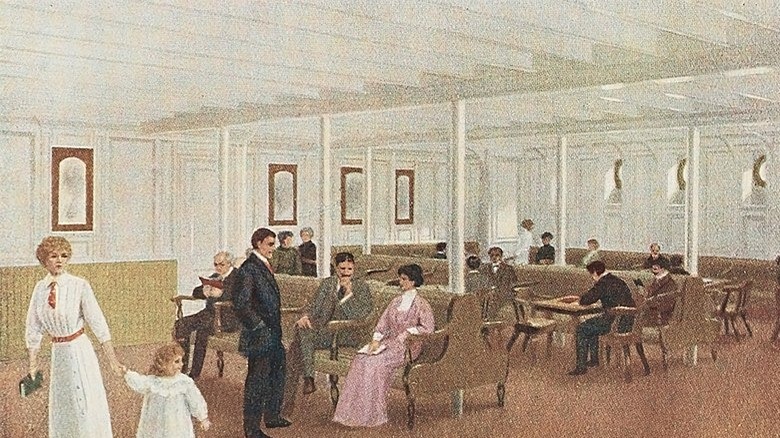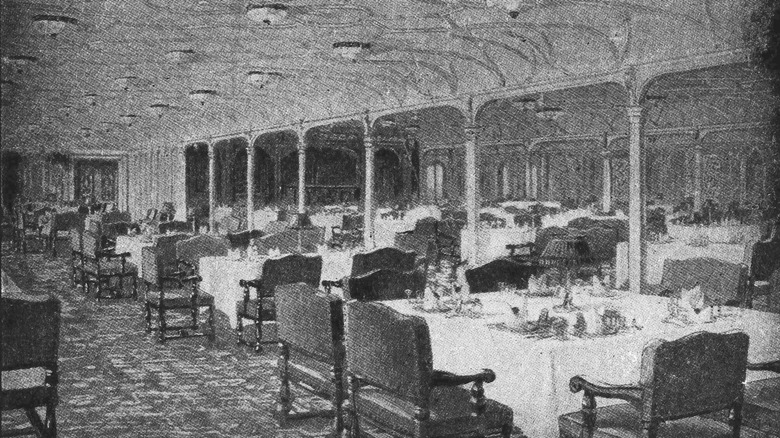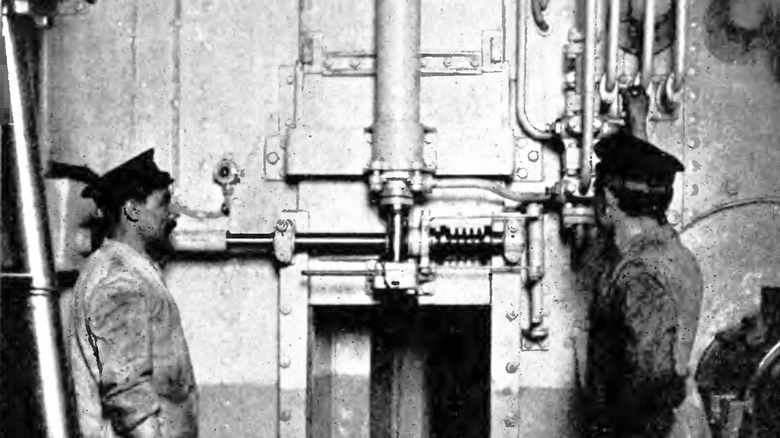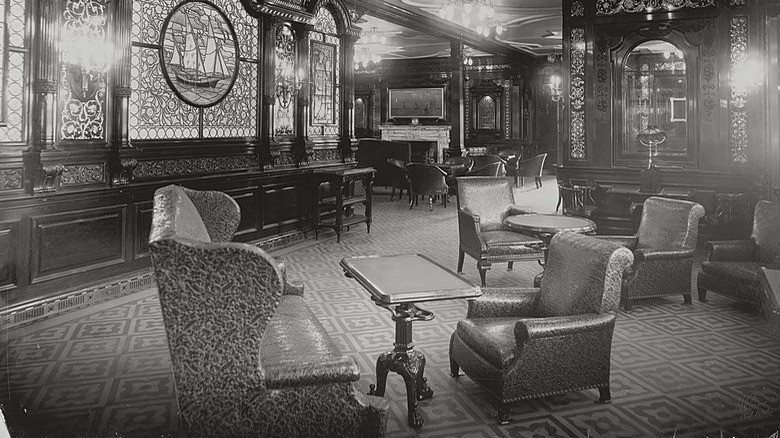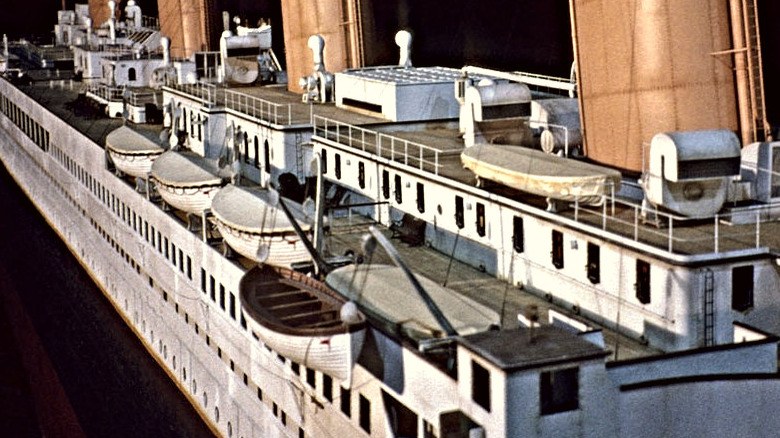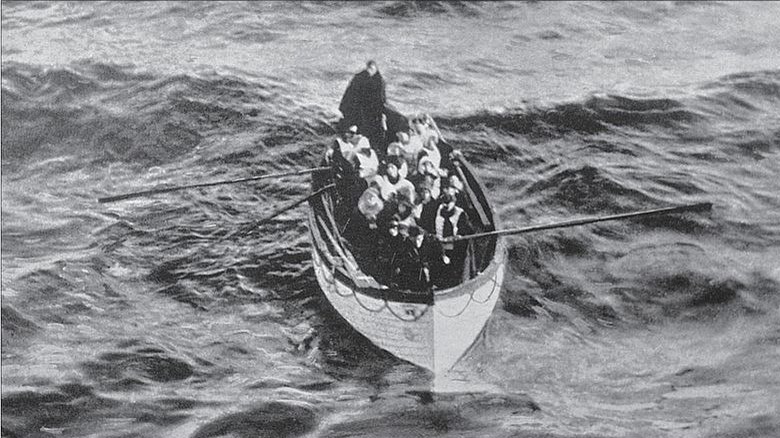What It Was Really Like To Be A Titanic Passenger
The Titanic was the largest sea faring vessel ever made at the time of its launch on May 31, 1911, as per History. Its many features and absurd size meant you would probably never get the chance to explore it all, even if it didn't sink on April 15, 1912. The Titanic was not just an engineering marvel but a great feat of artistry as well, as the History Press notes. The ship was designed to live up to the magnificent nature of its name with lavish accommodations and designs that were breathtaking for the time. Many of these marvels now sit at the bottom of the Atlantic Ocean.
Many first- and second-class passengers joined the voyage for leisure or emigrated from the port at Southampton, England. There was find running water and electricity across the entire vessel no matter who you were, but for those holding a lower class ticket, their experience was a little limited and more than a little cramped.
Here's what is was like to be a passenger on the world's most famous shipwreck.
A Scare Began the Voyage
When the Titanic set sail from Southampton, passengers settling into their cabin would have been jolted to hear a large cracking sound echoing through the ship — sounding as if a starting pistol was announcing the slow crawl that began the ship's voyage. Looking over the starboard side of the ship would have revealed the once-docked New York liner drifting towards the Titanic. The pull of the water moved by the Titanic was so strong that the metal cable that kept the New York to land had snapped, as reported in the Birmingham Daily Gazette in 1912 (via Encyclopedia Titanica).
An electrician positioned on a smokestack of the Titanic witnessed the scene from above, writing in a letter to his mother, "As soon as the Titanic began to move out of the dock, the suction caused the Oceanic ... to swing outwards, while another liner broke loose altogether and bumped into the Oceanic. ... I thought there was going to be a proper smash up owing to the high wind; but I don't think anyone was hurt."
The Birmingham Gazette reported on the incident, noting how close the three ships were, likening that one could throw a hat from ship to ship.
Hygiene Was a Luxury
If you were a third-class passenger, chances are you would have gone the entire voyage without bathing. According to the BBC, only two baths were shared among 1,000 people, so the opportunities to bathe would have been minimal. While there were public toilets on the ship, those who did not buy luxury cabins would have to do their business in a chamber pot provided for each room, as most living accommodations did not include private toilets. Often, however, these pots were used by seasick passengers. This gave the chamber pots the nickname of "vomit pots," according to an artifact exhibition at the National Museums of Northern Ireland.
For the more affluent voyaging on the Titanic, the cost of $1 (about $30 in today's money, after inflation) would allow you access the lavish Turkish baths. According to the National Museums of Northern Ireland, this room not only included toilets but steam baths and electric hot beds, a very recent invention for the time. Illustrations of the Turkish bath show elaborate Moroccan style windows and intricate patterning adorning the walls — a much more comfortable environment to clean yourself than a bathtub shared by a thousand other people.
Even Leisure Was Divided by Class
For the exercise aficionados, you would have needed to be a bit creative with your workouts if you did not have a first-class ticket. The ship's gym was limited to first-class passengers and charged an entry fee of one shilling (around $7.50 in today's money, after inflation), according to the National Museum of Northern Ireland. Advertising at the time by White Star Lines — the company that the Titanic operated under — boasted activities like electric horse riding, rowing, cycling, and other fitness programs. The gym was also supervised by a personal trainer hired as crew for the ship. Similar charges existed to partake in the first-class squash courts and swimming pool.
The second-class tickets did not provide as much access but still had plenty of recreation available to them on the ship. A spacious section of the ship's deck was committed to leisure for second-class passengers with deck games and deck chairs spread about a large space.
For a more relaxed setting, second-class passengers could spend their time in the library, which included tea served as refreshments. For the lowest class of passengers, however, very little was offered. If you were a member of this most populated section of passengers, the only space to relax was the third-class lounge, which was littered with advertisements on the wall for the White Star Lines other cruises and ships.
Opulence Was Always Front and Center
As a first-class passenger, you would have been greeted with a large and intricate staircase in the first-class lobby, shown by illustrations housed at the National Museums of Northern Ireland. The staircase stood wide and tall, like you would find in a high-class manor of the same time period. An intricate glass dome topped the finely crafted structure that climbed up through six decks of the Titanic. If you weren't that into walking, first-class passengers were given access to three elevators complete with cushioned seating, while second-class passengers had access to one.
Illustrations also show adornment on every facet of the ship. No matter where you looked on your walks through the halls and rooms of the Titanic, you would be met with intricate details, such as decoration on lighting fixtures and detailed linoleum floors, a new building material for the time.
Electric lighting was fitted through the entire ship, with lit beautiful electrical fixtures that lit the way through rooms and hallways. Expensive oak wood furniture upholstered with green leather, ornate blue and green wall tiles, and fine china tableware filled the various recreational and dining rooms on the Titanic. These features gave an impressive appearance, which reflected the lifestyle of the Titanic's most wealthy guests.
First Class Were the Richest of the Rich
If you're fantasizing about the lap of luxury that first-class passengers lived in on the Titanic, then you would be disappointed to find out that only the very wealthiest in society at the time could afford this expensive of a ticket.
The BBC estimates a ticket for the highest class suites as being equivalent to around £79,000 in today's money or over $96,000 after adjusting for inflation. Insider reports that the richest man in the world at the time, John Jacob Astor IV, was aboard the Titanic. With a net worth of $150 million ($4.5 billion in today's money, after inflation,) Astor was one of the few people on the Titanic who could have taken advantage of the modular aspect of first-class rooms.
The exhibits of the National Museum of Northern Ireland explain that some first-class passengers would book multiple rooms to expand the size of their on-board suite. Rooms in first class contained interconnecting doors, which would allow one room to be purchased for each family member, but would allow for the family to remain connected in one space. According to History, of the Titanic's ship log show that there were a total of 324 first-class passengers who were able to afford this expensive, and for many, final journey.
Poorer Passengers Were Shoved Towards the Back
For many of the poorer on the Titanic, chances are you were not on board for leisure. As the largest vessel at the time, the Titanic could fit a lot of passengers, and, according to the BBC, many of the over 1,000 third-class passengers were immigrants, seeking a new life in the United States. This number was large even for the Titanic, and as a third-class passenger your room would be packed, housing up to ten people, so you would want to hope you were bunking with people you were alright getting a little cozy with.
Besides, the cramped living quarters, night as a third-class passenger would have been particularly difficult. You likely would have been jarred awake because of the positioning of the third-class rooms next to the engines, which were particularly loud.
If you wanted to get away from all the racket,you wouldn't have much luck, as the third-class general room was also in the back of the ship, as per "Titanic: Destination Disaster," by Charles P. Eaton and Charles A. Haas. But at least accommodations were comfortable and nicely enough appointed, with pine and teak finishes throughout.
At least you would be able to stop into the third-class dining hall placed in the middle of the ship (via the National Museum of Northern Ireland) — but still a decent walk just to find a respite from the noise — the length of the entire ship was about 883 feet, according to statistics provided by the Royal Museums of Greenwich, so half that is still longer than the length of a football field.
The Food was a Step Up for the Time
No matter what class of passenger you were, you would have received a dining experience greater than on any other vessel at the time. Dana McCauley, author of "Last Dinner On The Titanic," describes the meals as a "... microcosm of three levels of Edwardian society represented in those menus" (via NPR). NPR also reports that the very last meal served on the Titanic was a 10-course dining experience with lamb, foie gras, oysters, and filet mignon, among other dishes. If the wide selection of options at the nightly dinners weren't your thing, you could spend a little extra to dine in the ship's à la carte restaurant, as per the National Museums of Northern Ireland.
Lower-class dining was not nearly as extravagant, but you wouldn't have a hard time staying full. Second-class passengers still had several courses per meal, but less options were provided to choose from.
If you were traveling third class, the quality of food would have been drastically lower. However, according to the BBC, you would still be better off than on most liners at the time, which required that third-class passengers bring their own food for the journey. The Titanic, on the other hand, offered freshly baked bread and fruit, as well as roast beef, biscuits, and rice soup. So if you weren't a foodie, even third-class accommodations would have probably kept you fed and content.
Nearly Half the People on Board were Crew
If you were any given person aboard the Titanic, chances are you were a member of the crew, with enough members to almost be bigger than the numbers that made up the third class of passengers, as per National Geographic. More specifically, there's a good chance that you would have had a lot of familiar faces to work with, as many of the workers came from the same town of Southampton in southern England, according to The Daily Echo. Over a hundred crew, about a tenth of the workforce, came form this city.
You would be glad to have friends to pal around with as crew, especially if you were one of the 150 crew assigned to be "stokers," a job responsible for keeping the boilers hot all day long. It was backbreaking work, with the BBC estimating a total of 600 tons of coal being shoveled a day.
For many other crew, the Titanic was one of many ships on which they made their career. These included stewardesses like Violet Constance Jessop, for whom the sinking of the Titanic did not scare her away from sea faring, having continued her work at sea until 1950, according to UK National Archives.
The Ship was a Smoker's Paradise
On a ship with nearly 8,000 cigars in its cargo, according to The Vintage News, you would never have to go far if you needed a smoke. The National Museums of Northern Ireland details the many smoking rooms that you could find as a passenger. For the men in the first and second class, if you were someone who fancied a smoke, you would usually find your way over to the smoking room after dinner, which included accommodations for drinking and playing cards.
The room was decorated with carved oak walls and exquisite stained glass and furnished with matching oak furniture to relax in. Third-class men could also relax in a smoking room that also had a bar and spittoons for chewing tobacco.
Women, however, were barred from entering the smoking room — meaning if you were one of the ladies of the Titanic you would either have to suppress the craving or find your way topside to sneak a smoke on the deck. At the time, smoking was used by many men as a way to socialize with other men, and social conventions of the era kept women separated. Gender created a social class within each of the social classes of the Titanic.
Sunday was Lifeboat Drill Day
A couple traditions would define every Sunday for passengers and crew on the Titanic. For passengers, Anglican church services were offered inside the dining hall, and for the crew, there was a weekly lifeboat drill, according to reporting by the Toronto Star. However, on Sunday, April 14, 1912, crew members neglected what was usually a typical exercise for ocean liners.
As it turns out, a Senate report investigating the crash of the Titanic revealed that crew members only conducted the drill once prior its sinking. The drills only included the lowering of two lifeboats of the ship's 20 total emergency craft. The investigation also revealed the total capacity of emergency craft on the Titanic was just 1,176, or about half of the total people on the ship. As passenger or crew however, there would not have been much anxiety about these numbers and practices in a vessel lauded to be disaster-proof.
As the vessel began to sink, the crew's lack of experience would be quite evident. The Senate report goes on to note that there was no true system in place for the lifeboats, including how to organize the passengers, where the boats should be loaded, and even how many crew members should man them. Sadly, the boats would be filled under their capacity, resulting in lives lost needlessly.
Pets were Allowed, for the Right Price
For dog lovers, canine friends were permitted on the ship for half the price of an adult's ticket (via The National Museums of Northern Ireland), and they were limited to only members of the first class, according to HuffPost. There were 12 passengers who took advantage of this and brought their dogs on board with them, where they were kept either in their cabin or in the ship's kennel. There is a chance that walking the halls of the first-class cabins, you would have heard the yaps and yips of two of the Pomeranians that were brought on board.
Some dogs even survived the wreck. Of the 12 dogs that were brought on board, three survived, all small dogs. Both Pomeranians were saved, as well as a Pekingese.
These furry friends reveal that at some points during the evacuation, spirits were relatively high, as a passenger felt comfortable joking, "Oh, I suppose we ought to put a life preserve on the little doggie, too," when first class passenger Margaret Hays brought her Pomeranian, Lady, onto lifeboat number seven.
Other dog owners were not as confident that evacuees would be able to make light of the situation, with first-class passenger Elizabeth Rothschild hiding her own Pomeranian in her coat throughout the entire voyage of their life boat.
Class Impacted Who Survived
After the disaster, a Senate hearing took place to investigate the disaster and what went wrong. After hearing surving crew testimony, the report concluded that class had nothing to do with allocation of lifeboats, and that class was not inquired upon when assigning people to lifeboats. Roger and June Cartwright reveal in "Titanic: The Myths and Legacy of a Disaster" that the lifeboats were on the top deck, so third-class passenger cabins were the farthest away from where the boats were launched.
If you were in third class when disaster struck, you would be caught in the halls with a thousand other people, trying to make your way up to the lifeboats, which the first-class passengers could have more easily walked to. As History notes, some attempts to explain the disproportionate deaths of third-class victims were that the language barrier proved problematic or that they were simply afraid to evacuate. Walter Lord in "The Night Lives On" argues that testimony at the hearings clearly showed the men and women of third class were intentionally held back.
According to the Revue d'Épidémiologie et de Santé Publique, further investigations highlighted that inaccessible lifeboats, lack of crew support, and blocked escape routes were among the discriminatory practices that caused such a large loss of life among third-class passengers.
